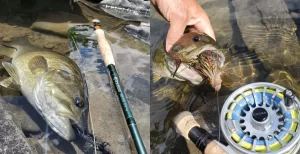Pairing fly fishing with bass fishing may seem unconventional, but it opens up a world of exciting challenges and memorable catches. Known for their aggressive bites and strong fights, bass present a thrilling opportunity for fly anglers looking to branch out from trout. With a few adjustments to technique and gear, fly fishing for bass becomes a rewarding adventure that’s accessible and beginner-friendly. Here’s what to know about gear, techniques, and bass behavior for those ready to make the switch.
Bass Species to Target
There are three main bass types worth targeting on a fly rod: smallmouth bass, largemouth bass, and striped bass (stripers). Smallmouths are usually found in cooler waters, often alongside trout in clear streams and rivers, and they’re identifiable by their bronze and greenish hues. Largemouth bass, with their dark lateral line and wider jaws, tend to prefer warmer, shallower waters in ponds or lake edges. Stripers, the largest of the three, are coastal fish known for their striking dark stripes and robust size, often weighing 40 pounds or more. Each of these species brings unique excitement to fly fishing, though stripers may require saltwater gear and an extra challenge due to their larger size.
Fly Fishing Gear for Bass
While a standard 9-foot, 5-weight fly rod is sufficient for many trout waters, targeting bass often demands a sturdier setup. A 9-foot, fast-action 6- to 8-weight rod is ideal, offering the strength to cast large flies and manage powerful strikes. For stripers, consider stepping up to a 10-weight rod like the Orvis Helios, equipped to handle both the size of the fish and the corrosive effects of saltwater.
Bass-specific lines are essential for handling heavier flies. The Scientific Anglers Amplitude Smooth Titan Long line and Cortland Bass Intermediate Series are great options. These lines provide the weight-forward taper needed for easy casting of big, wind-resistant flies and allow the angler to work the fly down to depths where bass often hold. Leaders and tippets for bass are thicker than trout setups, with 2x to 4x leaders in 7.5 to 9 feet being common.

Best Flies and Techniques
Bass are voracious feeders with a penchant for flashy presentations, so fly patterns should reflect this. The three main types of flies for bass are poppers, nymphs, and streamers. Poppers, like blockhead poppers, are surface flies that mimic distressed prey, making them perfect for a bass’s aggressive nature. When fished along the edge of cover, these flies create enticing movement that often triggers explosive surface strikes. Streamers, especially wooly buggers, work well when cast parallel to shorelines and stripped in short bursts to imitate injured baitfish. In rivers, dead-drifting or slow-twitching nymphs like the black stonefly can also prove effective, especially in slower waters where bass wait for prey.
Adapting Techniques to Conditions
Adjusting to water conditions is crucial for successful bass fly fishing. Bass in colder water are less aggressive, so slow retrieves with intermittent pauses are often effective. In warmer water, a faster retrieve with sharper strips can provoke bites. Bass are also drawn to structure, so target areas with weed beds, downed trees, or submerged rocks.
Hooking and Fighting Bass
Unlike trout, bass hit hard and require a unique hook set. Rather than a quick, high pull, a moderate lift with tight line management is best to ensure the hook sets securely in the bass’s wide mouth. Bass are strong fighters, often jumping when hooked, so be ready to bow or release slack if they leap. Proper line management is crucial to avoid losing them mid-fight.
The Reward
Catching bass on a fly rod brings a thrilling experience that differs from trout fishing. With a mix of power, aggression, and adaptability, bass are a perfect target for fly anglers looking for new challenges. As spring and summer roll around, bass fly fishing offers both seasoned and new anglers a chance to catch a fish that will leave them wanting more.
Image/Source: WOS





